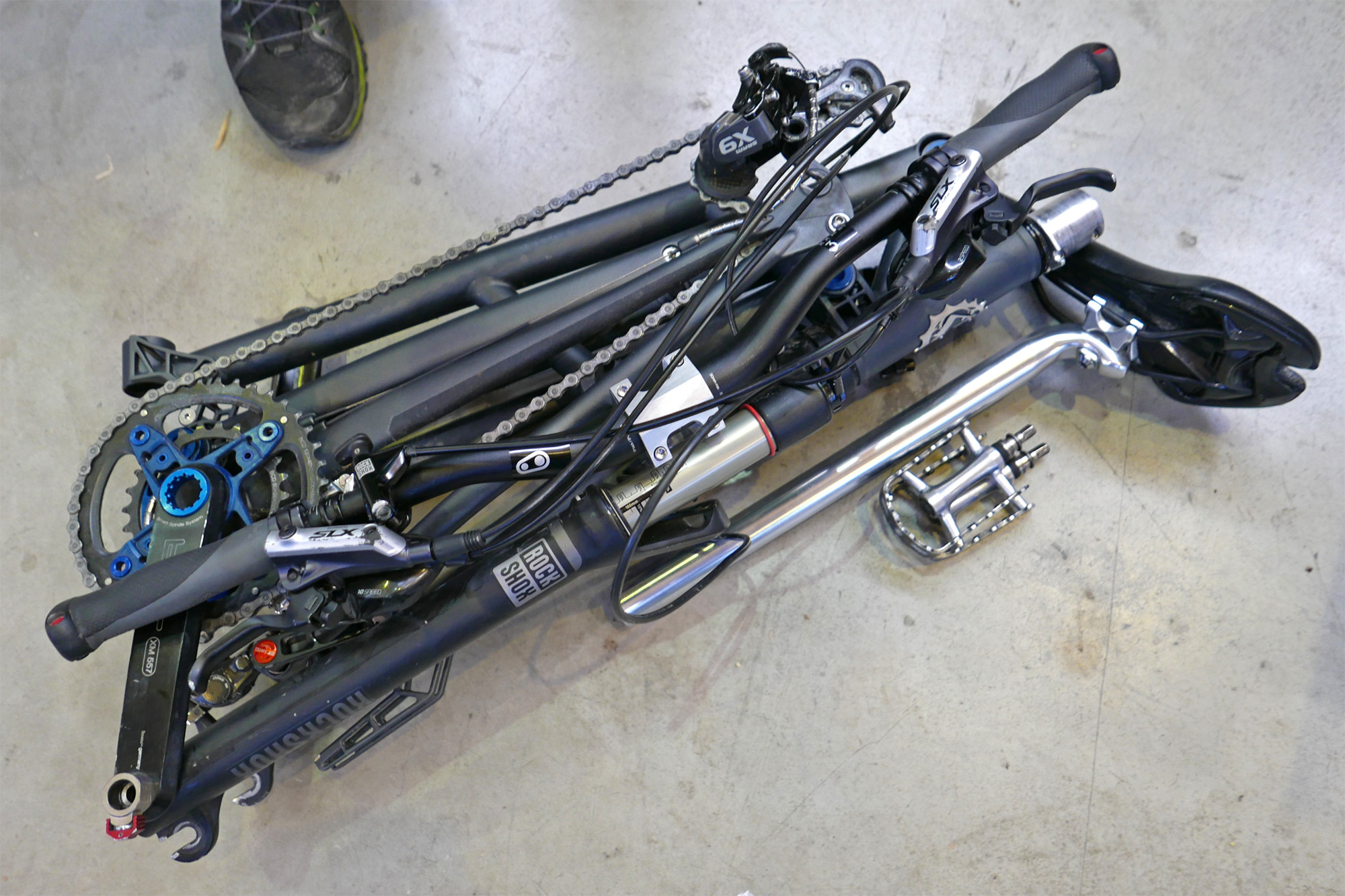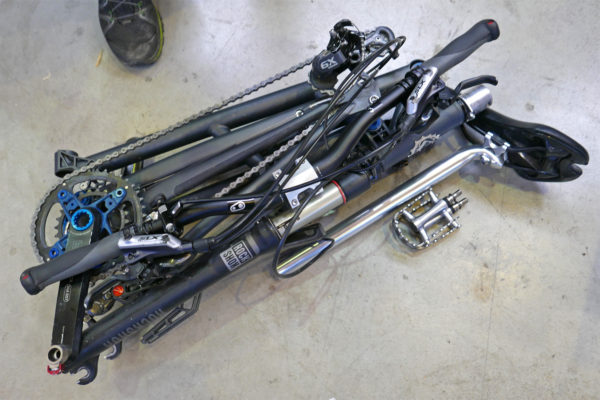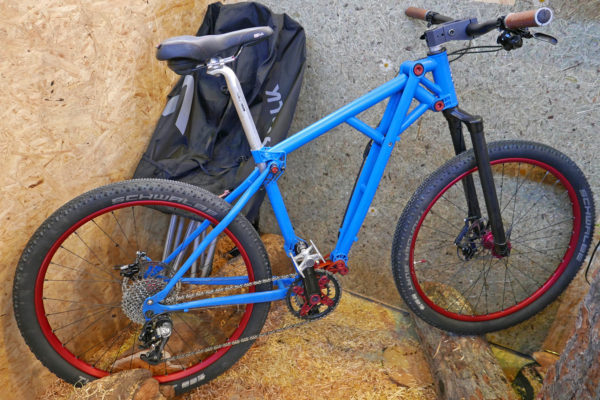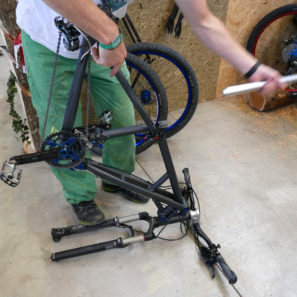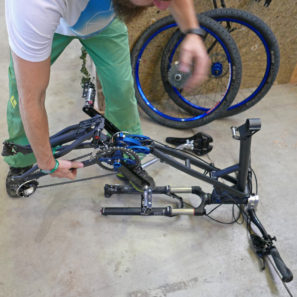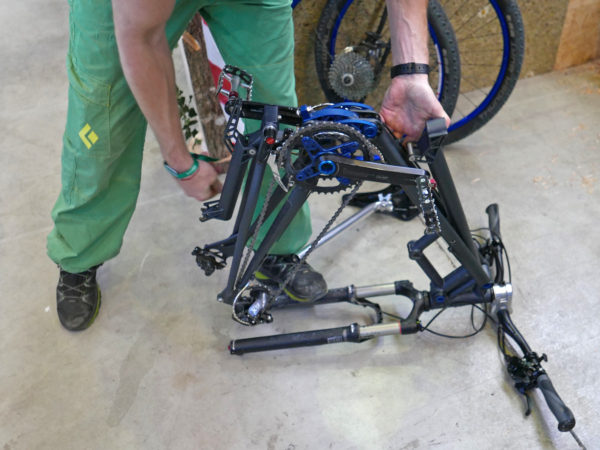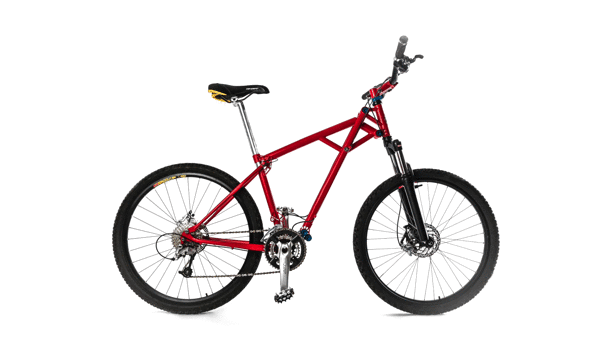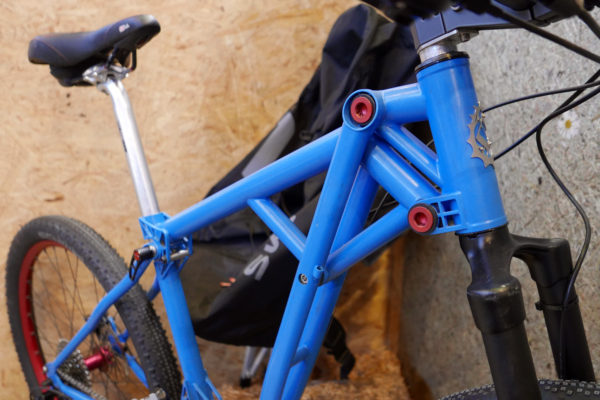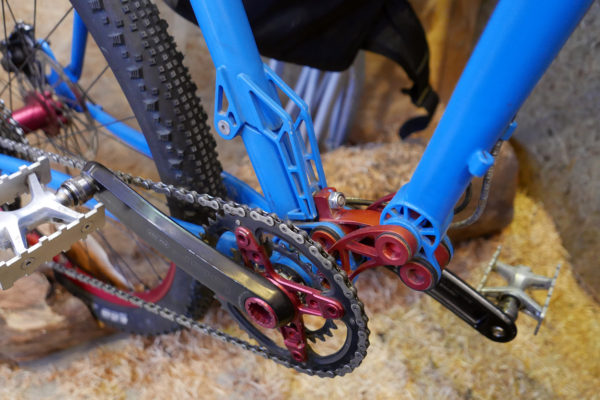No, that isn’t a pile of tubing and components that will eventually be fabricated into a rideable bike. It is actually a complete 27.5″ trail riding hardtail (minus the wheels of course) that will unfold and be ready to ride in about 90 seconds. The brainchild of Austrian designer, tinkerer, and framebuilder Thomas Schwaiger, the East folding bike was conceived originally as a way to take a proper mountain bike and stick in inside of a backpack so that he could haul it along when he went paragliding. A few optimized generations later and the current bike has adapted to provide stiffness on par with an aluminum full-suspension bike and breaks down so small that it can be easily transported anywhere you want to go, then stored out-of-the-way when you get back home…
And that is the bike in its unfolded form. This 26″ blue bike is a slightly earlier iteration with more cross country aspirations and a rigid fork, but after putting in thousands of kilometers off road Schwaiger, or rather Tonkel Om as he is more often called, has moved forward to building the bike into something of an all-mountain trail hardtail that can take on any style of mountain bike riding when paired with a suspension fork. We didn’t talk much about geometry as the bike is still in a prototype form, with a few more months of testing before it more-or-less goes live in the spring of 2017.
What we mostly focused on was the folding. 90 seconds from a bike to a pile of parts is a bold claim, but Tonkel Om could do it in about half that. The longest amount of time seemed to actually be pulling the wheels off and setting them aside (even with QRs.) Then when the bike is resting on the fork with the rear triangle in the air, you simply unhook the DT Swiss RWS seatpost clamp that hold it all together and pull the seatpost out.
Note that the bike has a pretty beefy looking alloy post. It is essentially the linchpin that holds the entire bike together, so no skimping on material there. Big thick and aluminum seemed to be a wise option.
Once the seatpost is out, the bike frame goes limp pretty quick. Then a little bike origami happens as you extend the frame out backward horizontally, getting the front end to collapse and the remains of the seattube to fold out of the way. Then, tuck the folded chain & seatstays back under the downtube and the whole thing folds flat into a bundle of tubing.
We were a bit surprised that it folded down this flat and didn’t require any removal of the drivetrain or cabling (with everything routed externally along the downtube and chainstays and rotating around the BB). Tonkel Om includes a quick release stem (at the steerer tube clamp) and QR removable commuter flat pedals to break it all down fast. The way it folds, I’d guees that you are likely to end up scratching the paint on pretty much every element over the life of the bike, but looking at the older ones here, clearly the powdercoating was durable enough, as I didn’t notice much evidence of abuse.
It’s kind of shocking to see a full size bike fall apart into a pile of pieces so quickly. Have a look on youtube if you want, of it getting reassembled (without being sped up in around 30 seconds). My first thought was that it would be unstable to the touch and certainly that it would ride like a wet noodle, but… Trying to flex the complete bike by hand showed that it was stiffer than expected, and Tonkel Om assured us that it was designed to be stiff. Between precision pivots and a design that actually locks in place as it is rotated into shape & tightened, it seems reasonable to think that it could be as rigid as an aluminum full suspension bike that has just as many pivots, as he claimed.
The key to the design is the collapsing shape and truss-like layout of the front triangle. Wherever possible the pivots are widely spaced to deal with those twisting forces that turn steering inputs into control and wheel tracking out on the trail.
Around the East bike’s bottom bracket is where everything gets really complicated. It’s also where a good bit of the engineering time developing the bike was spent. There certainly are more linkages here than you will find on even most virtual pivot full-suspension bikes, but are needed to get all the tubes to fold around and nest over each other without interfering with the fixed link from the BB to the rear derailleur. It is interesting to note that in this prototype the bolt on the middle red link is what the East bike uses to dial in that last bit of fine-tuned tension adjustment holding the rideable bike in place.
All in, the 27.5″ bike claims to weigh just 12.5kg (27.5lb) and folds down to a 20 x 32 x 75cm (8 x 12.5 x 29.5″) bundle, without the wheels. That makes in portable enough to drop into almost any decent sized backpack, then all you need is a couple of wheel bags and you are off.
We’re very curious to see this make the jump to regular production. And to be honest I’d like to hit some trails with it as well, to see how it really handles when you encounter actual trail obstacles like ruts, rocks & roots, all of which can be a mess on a flexy bike. The moment we hear news on the progress of the East folder, we’ll be sure to share it.
